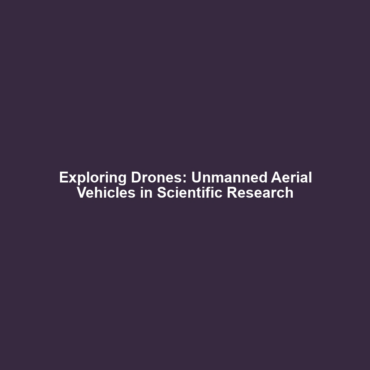What are Drones?: An Overview of Unmanned Aerial Vehicles (UAVs) in Scientific Research
Introduction
Drones, or unmanned aerial vehicles (UAVs), serve a crucial role in scientific research, offering innovative methods for data collection and analysis across various disciplines. As precision tools that can access hard-to-reach or hazardous environments, drones have transformed how researchers conduct studies in fields such as ecology, agriculture, climate science, and more. This article delves into the significant impact of drones in science, highlighting their applications, challenges, and potential future developments.
Key Concepts
Understanding Drones
Drones are programmable flying devices, often equipped with sensors and cameras, that enable researchers to gather data aerially. Key concepts include:
- Flight Technology: Understanding the mechanics and electronics behind UAV operation.
- Sensor Integration: Utilizing various sensors for collecting environmental data, such as temperature, humidity, and visual imagery.
- Data Processing: Analyzing the data collected through advanced software tools to generate useful insights.
These principles underscore their role as crucial tools within the domain of Drones in Science.
Applications and Real-World Uses
Significant Applications of Drones in Scientific Research
Drones have a multitude of applications across scientific research, enhancing capabilities and efficiency. Some practical uses include:
- Agricultural Monitoring: Drones are used to monitor crop health, assess soil conditions, and perform precise irrigation management.
- Ecological Studies: UAVs facilitate the surveying of wildlife populations and habitats, enabling researchers to gather data without disturbing ecosystems.
- Disaster Response: In the aftermath of natural disasters, drones can quickly assess damage and support recovery efforts by mapping affected areas.
These examples illustrate how drones are used effectively in various scientific fields.
Current Challenges
Challenges of Drones in Scientific Research
Despite their advantages, there are challenges and limitations in applying drones for scientific research, including:
- Regulatory Constraints: FAA regulations and restrictions make it complicated for researchers to operate UAVs in certain airspace.
- Technical Limitations: Battery life and payload capacity can limit a drone’s operational range and capabilities.
- Data Privacy Issues: The collection of images and video raises concerns about privacy and data protection.
Addressing these issues is vital for the continued advancement of drones in science.
Future Research and Innovations
Next-Generation Innovations in Drone Technology
Looking ahead, upcoming research and innovations continue to shape the role of drones in science. Key trends include:
- Autonomous Flight: Developing AI-driven drones capable of conducting missions without human intervention.
- Enhanced Sensors: Innovations in sensor technology are leading to better data accuracy and reliability.
- Swarm Technology: Employing multiple drones to work collaboratively for larger-scale data collection and analysis.
Such advancements promise to expand the capabilities and applications of drones in scientific research.
Conclusion
Drones, or unmanned aerial vehicles (UAVs), are revolutionizing scientific research across numerous disciplines, providing unprecedented methods for data collection and analysis. Their applications, from agriculture to disaster response, showcase their vital role in modern science. However, addressing the challenges they present will be crucial for further development. For continued exploration of innovative technologies in research, visit our related articles section.

